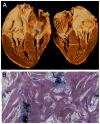Identifying sarcomere gene mutations in hypertrophic cardiomyopathy: a personal history
- PMID: 21415408
- PMCID: PMC3072749
- DOI: 10.1161/CIRCRESAHA.110.223834
Identifying sarcomere gene mutations in hypertrophic cardiomyopathy: a personal history
Abstract
This review provides an historical and personal perspective on the discovery of genetic causes for hypertrophic cardiomyopathy (HCM). Extraordinary insights by physicians who initially detailed remarkable and varied manifestations of the disorder, collaboration among multidisciplinary teams with skills in clinical diagnostics and molecular genetics, and hard work by scores of trainees solved the etiologic riddle of HCM and unexpectedly demonstrated mutations in sarcomere protein genes as the cause of disease. In addition to celebrating 20 years of genetic research in HCM, this article serves as an introductory overview to a thematic review series that will present contemporary advances in the field of hypertrophic heart disease. Through the continued application of advances in genetic methodologies, combined with biochemical and biophysical analyses of the consequences of human mutations, fundamental knowledge about HCM and sarcomere biology has emerged. Expanding research to elucidate the mechanisms by which subtle genetic variation in contractile proteins remodel the human heart remains an exciting opportunity, one with considerable promise to provide new strategies to limit or even prevent HCM pathogenesis.
Figures


References
-
- Brock R. Functional obstruction of the left ventricle; acquired aortic subvalvar stenosis. Guys Hosp Rep. 1957;106:221–238. - PubMed
-
- Morrow AG, Braunwald E. Functional aortic stenosis; a malformation characterized by resistance to left ventricular outflow without anatomic obstruction. Circulation. 1959;20:181–189. - PubMed
-
- Braunwald E, Ebert PA. Hemogynamic alterations in idiopathic hypertrophic subaortic stenosis induced by sympathomimetic drugs. Am J Cardiol. 1962;10:489–495. - PubMed
Publication types
MeSH terms
Grants and funding
LinkOut - more resources
Full Text Sources
Other Literature Sources

